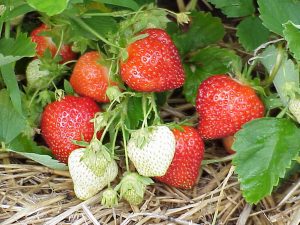Strawberry IPM Newsletter No. 5 – June 12, 2020
Strawberry IPM Newsletter No. 5 – June 12, 2020
Click on photos to enlarge
EARLY STRAWBERRY HARVEST BEGINS IN SOUTHERN MAINE
Tarnished Plant Bug, Spider Mites and Gray Mold Most Common Threats
Twilight Meeting Tuesday June16, 2020 at Blackie’s Farm Fresh Produce in Auburn, Me
Situation:
We’ve finally had some good growing conditions for strawberries this week, and we’re seeing excellent flower and fruit development in most fields. There should be some ripe fruit to harvest from early beds in southern Maine this weekend. As harvest time approaches, you should finalize your plans for managing customers under the COVID-19 guidelines. There is a lot of good information on reducing the risk of transmission in pick-your-own fields available on our website, listed below. Reducing the risk of infection as much as possible is essential for keeping: you, your staff, and your customers safe, and for keeping your farm open and profitable.
Strawberry bud weevil or “clipper”:
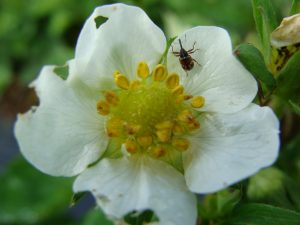
Although I did see a few clipped buds this week, most fields are well beyond the point where clippers could cause significant damage. However, late blooming varieties in northern fields that still have a high percentage of closed flower buds should continue to be scouted, and protected, if the threshold of more than 1.2 clipped buds per 2 feet of row is exceeded.
Tarnished plant bug:
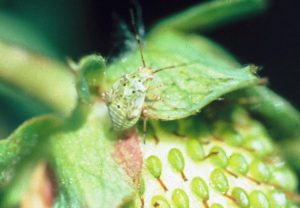
Two fields scouted this week were over the control threshold for tarnished plant bugs. Most were very small nymphs, but there were some larger nymphs and adults were also present. The threshold for plant bugs is 4 or more flower clusters infested with nymphs per 30 sampled. These insects will continue to feed on developing fruit after petal fall, causing misshapen fruit or “catfacing”.
Two-spotted spider mites:
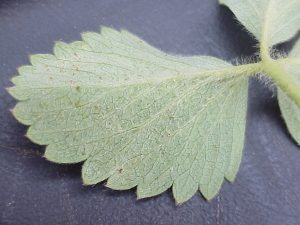
Spider mites were found in most fields scouted, but were below the control threshold. For those fields close to harvest, control strategies may best be applied after bed renovation, including the release of predatory mites into the fields to help suppress the spider mites.
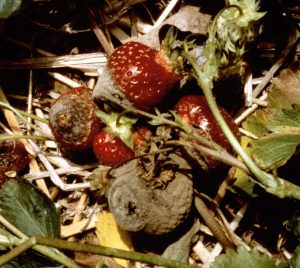
Diseases: gray mold (Botrytis) Bloom sprays to prevent gray mold should be wrapping up in most fields, unless they are being watered with overhead (sprinkler) irrigation. Flowers should be protected against infection with fungicide sprays if more than one inch of water, either from rainfall or irrigation, has fallen on the field since the last fungicide application.
Birds, especially Cedar Waxwings, have been moving into fields to feed on ripening fruit. When Cedar Waxwings are a problem, only keeping a near constant presence in the field and eliminating roosting sites can reduce the damage. Some chemical repellents containing methyl anthranilate (e.g. Avian Control®), are registered for use on strawberries. Although most scientific studies with these products have not found them to be very effective, some growers have claimed good results. Remember that songbirds are protected by law and should not be killed. However, permits may be issued for killing birds by the U.S. Fish and Wildlife Service if they receive a recommendation for such a permit from the Maine Wildlife Services Office (part of the United States Department of Agriculture (USDA) Animal and Plant Health Inspection Service) in Augusta, along with an application from the grower. There is a $50 fee for the application, and it may take over a month for the permit to be processed. However, the permit is good for one year, so if you have problems this season, you may consider applying for a permit this winter, which would allow you an option to kill birds, if necessary, next season. The Wildlife Damage Office has recommendations for managing birds in crops, and also has some control options available through their office. For more information on permits or bird control contact the office in Augusta at 207.629.5181. The office is located in the Capital West Business Center at 79 Leighton Road in Augusta.
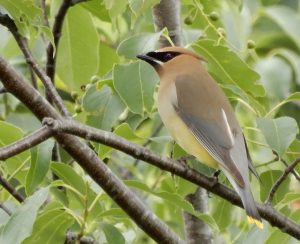
Annual Pre-Harvest Checklist for Pick-Your-Own
Is your farm ready to provide your customers with the best possible picking experience? This is especially important with the challenges of the corona-virus pandemic. Inform your customers of new guidelines, including social distancing and sanitation protocols, in all of your publicizes so they know what to expect when they arrive on your farm.
- Your phone message and web/social media pages with picking conditions and opening and closing times should be regularly updated, and provide information about how fields are being managed to protect customers from COVID-19.
- There is easy access to the fields and plenty of parking. If possible, entries and exits should be on opposite sides of the lot to reduce cross traffic and congestion.
- Someone is ready to greet customers and offer parking instructions and directions to the field. Protective face masks or shields should be worn by both staff and customers. Disposable masks should be available for customers.
- Access to the field is free of hazards. Entries and exits should be on opposite sides of the field. All foot traffic should be one way up the rows. Use flags to mark where the last customer stopped picking, and the next should begin, Customers should stay in assigned rows and not allowed to be within 6 feet of other customer groups
- If transportation is provided for the elderly and disabled, follow social distancing as much as possible, e.g. no group transportation, and as much space as possible between riders and drivers.
- The rules regarding picking, distancing, sanitation and traffic flow are clearly posted.
- Someone is in the field to show customers where to pick, explain new picking guidelines, and to answer questions.
- Restroom and hand washing facilities are available and regularly cleaned and sanitized. Customers should wash hands before entering the field. Instructions for proper hand washing should be posted
- Fruit and containers should be handled as little as possible. Have shields set up at weigh stations and checkouts between customers and staff. Scales and countertops should be sanitized frequently. Customers should maintain distancing during the checkout process. The entry and exit from checkout should be one way; no cross traffic.
- No playgrounds, petting zoos, picnic areas, etc. Customers should be discouraged from congregating at the farm.
- The help is friendly and knowledgeable.
The pandemic has forced us to eliminate one of the greatest attractions of the pick-your-own experience; social gathering. However, by keeping the customers informed about your concerns for safety and providing, as much as possible, a friendly, clean, efficient and organized atmosphere, you will build trust and good faith with them, encouraging them to return and recommend your farm to their friends.
COVID-19 information for farmers: For more information regarding growing and marketing crops under COVID-19 restrictions please visit our webpage:
https://extension.umaine.edu/agriculture/
Reminder: Twilight Meeting Tuesday June 16th at Blackie’s Farm Fresh Produce, 966 Minot Ave., Auburn, starting at 6:30 p.m. One pesticide applicator recertification credit will be awarded for the meeting. See you there!
Sincerely,
David T. Handley
Vegetable and Small Fruit Specialist
Highmoor Farm Pest Mgmt. Unit
P.O. Box 179 17 Godfrey Drive
52 U.S. Route 202 Orono, ME 04473
Monmouth, ME 04259 1.800.287.0279
207.933.2100
The University of Maine is an equal opportunity/ affirmative action institution.
Where brand names or company names are used, it is for the reader’s information. No endorsement is implied nor is any discrimination intended against other products with similar ingredients. Always consult product labels for rates, application instructions and safety precautions. Users of these products assume all associated risks.

